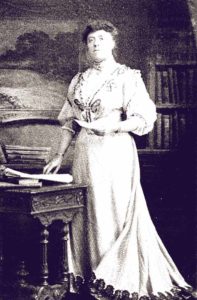From Chalbury to Fleet Street
Roger Guttridge recalls a pioneer of women’s journalism
Published in August ’18

Mary Billington: a ‘commanding figure’. It was said that perhaps no task in the round of journalism was beyond her capabilities.
She’s largely forgotten in her native Dorset, which seems an injustice given Mary Billington’s status as an undisputed pioneer of women’s journalism. In an era when the campaign for women’s suffrage was high on the news agenda, she was one of a handful of women who made deep inroads into a previously male terrain.
In an obituary following her death in August 1925, the Daily Telegraph described Mary as the ‘doyenne of women journalists’ and one who had played a leading role in early efforts to organise them. She was a founder of the Society of Women Journalists, its president from 1913-21 and in 1920 represented the society at the Imperial Press Conference in Canada.
‘When she came into Fleet Street, the few women writers for newspapers could be counted on the fingers of one hand, and they were rather contributors upon special subjects than well-equipped journalists,’ said the Telegraph. ‘She was one of the first to tramp its pavements in a daily occupation, to take her place in the office organisation of a daily newspaper, and to share with men the round of diversified work which the supply to the public of their news entails.’
Mary was born in 1862 at Chalbury, near Wimborne, where her father, Rev. George H Billington, was the rector. Her mother, Frances, was also a clergyman’s daughter. The Telegraph described Chalbury as ‘a Dorsetshire parish remote from the stirring scenes which it afterwards became her life’s work to chronicle.
Mary contributed to Dorset newspapers before tentatively dipping her toe into Fleet Street’s more turbulent waters. It was ‘somewhat tremblingly’ that she sent an article to The Globe, an illustrious publication whose columnists were soon to include P G Wodehouse of Jeeves fame. Her effort so impressed the editor that he published it on the front page, filling a whole column and running onto page two. Mary was paid a guinea (£1.05) and experienced ‘the thrill that many a journalist recalling his salad days remembers so well’.
Other freelance successes followed, but Miss Billington’s next big break was an introduction to publisher and philanthropist John Passmore Edwards. In 1888 she helped him to launch the Southern Echo at Southampton, a paper that in turn was to spawn a ‘lusty infant’ (as that company’s own historian once put it) known as the Bournemouth Daily Echo in 1900, followed in 1921 by the Dorset Daily Echo. This trio of lusty dailies have dominated journalism along the Dorset and Hampshire coast ever since.
Edwards also owned London’s first halfpenny evening paper, The Echo, and Mary Billington audaciously suggested that he hire her as a staff journalist. ‘That was a daring innovation, to arm a woman with the office card, and send her out to describe events and report happenings; and he thought twice. But that considerate helper of so many beginners was persuaded, and Miss Billington took her place in London journalism, never thereafter to leave it.’
In 1890 she joined the Daily Graphic, which was about to be launched as the first daily illustrated newspaper. Her assignments included the funeral of the Poet Laureate, Alfred, Lord Tennyson, at Westminster Abbey and the Royal Navy Exhibition, where she donned a diving suit to experience life underwater. She also filed 28 reports from India, which later became Woman in India, the first of her three books.
In 1897, her reputation now firmly established, Mary joined the Daily Telegraph, with whom she was to remain until her death 28 years later. At a time when the campaign for women’s suffrage was one of the big issues, she led the Telegraph’s women’s department and wrote a weekly column on women’s working lives.
During World War 1, Mary first reported from the Home Front before heading for France, where she toured military hospitals and the camps of the Women’s Auxiliary Army Corps. ‘Her sympathetic account of her countrywomen’s work in the theatre of war, and of the part they played with so much heroism and endurance, will be well remembered,’ commented the Telegraph. Her war reports led to her two other books, The Red Cross in War and The Roll Call of Serving Women.
Mary also reported on royal and other grand occasions and built a strong relationship with the royal family, particularly Queen Alexandra. During the last days of her life, she was ‘much cheered’ by messages and flowers from Queen Mary.
Mary Billington died a week short of her 63rd birthday and is buried in Chalbury churchyard alongside her parents and brothers. In its final tribute, the Telegraph reported: ‘Tall, a commanding figure, she was very familiar at public and especially ceremonial gatherings of the past three decades. There were few tasks in the round of journalism which Miss Billington could not and did not, in fact, accomplish – perhaps none was beyond her capabilities had they been tested. She had a rapid pen and was undismayed by the rush with which sometimes work has to be performed. She had in generous measure that great quality of the born journalist – she was versatile.’

